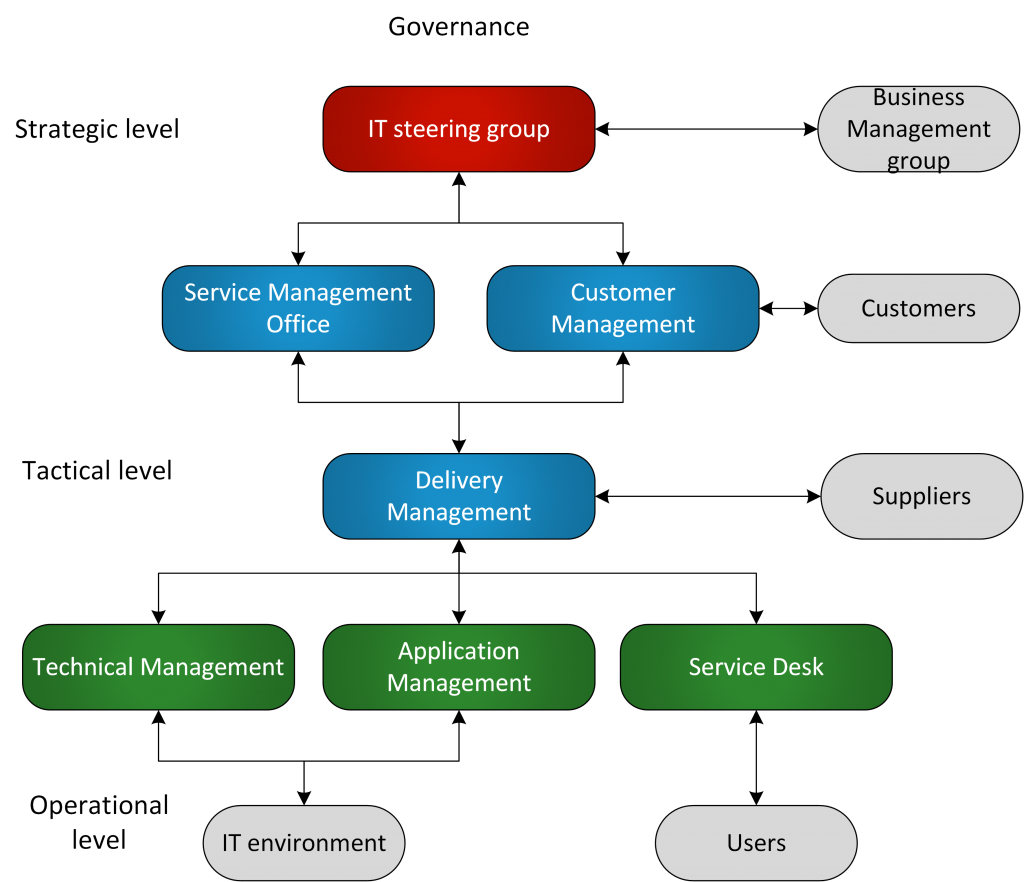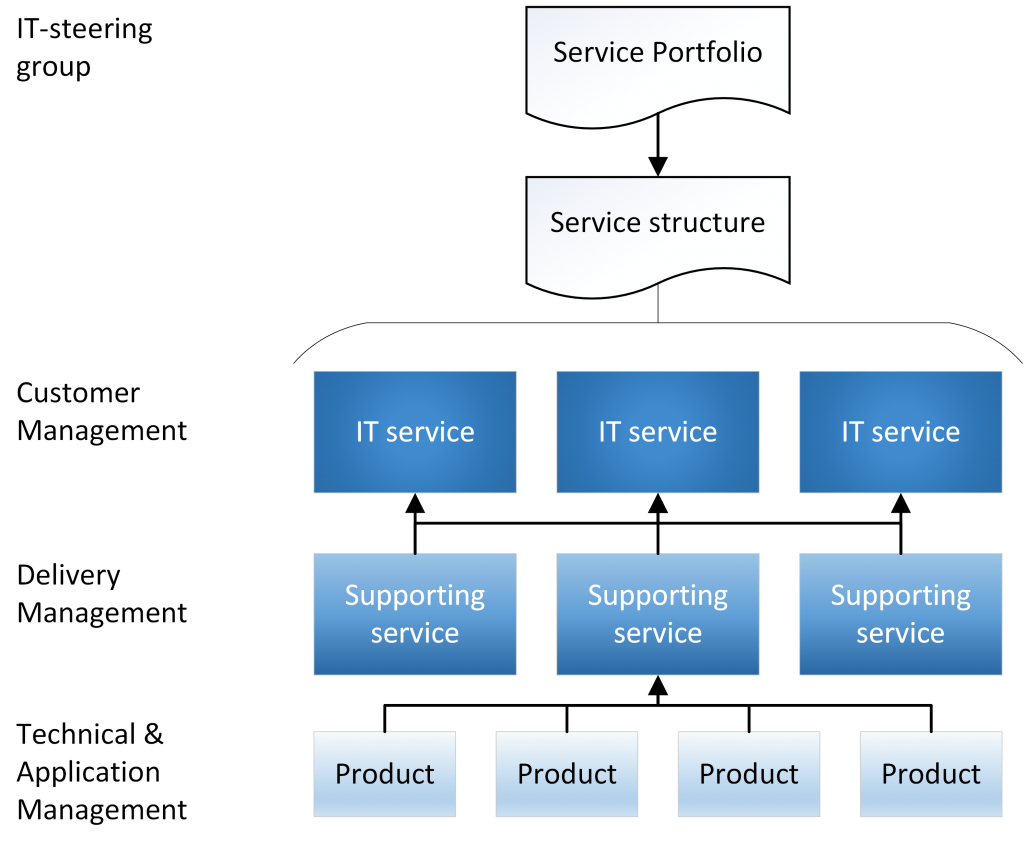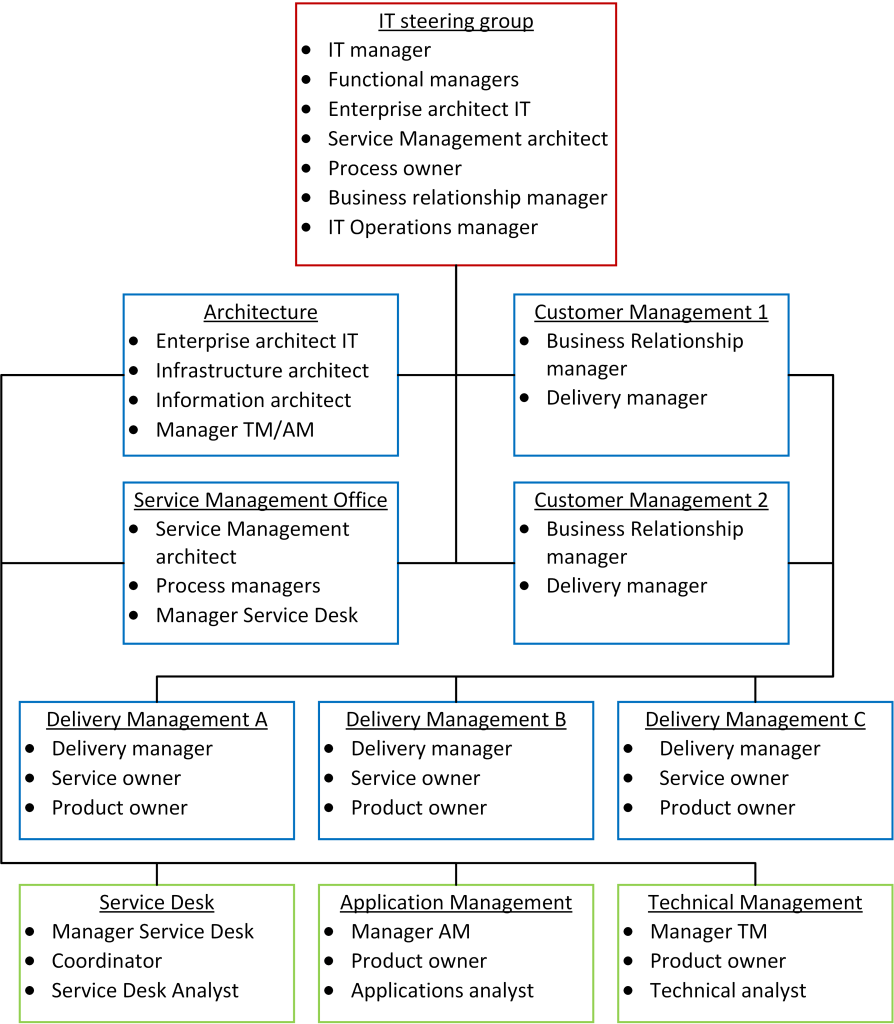Communication and control are important aspects in all operations. Unfortunately, many organizations get stuck in an eternal carousel of meetings. The meetings are often based on a specific issue and are managed through inviting individuals to attend. These key individuals then end up in a situation where the working week is filled with meetings.
The aim is to deal with each issue just once and in the right forum. A governance model for the IT organization is used to achieve this. The governance model in TRIM uses the defined functions in the IT services’ life cycle phases with different responsibilities and clear communication channels so that issues can be collected together and managed in the right function. This makes the key individuals the starting point for the meeting and the issue comes to them instead of vice versa.
The model contains seven functions divided over three levels. The functions can vary in size and number depending on the scope of the IT organization. For example, a large organization can establish a Customer Management function for each unit in the business, while a smaller organization has one Customer Management function for the entire business.
Each function is described in more detail later in this book, while the model’s overall structure is described here.

Strategy level
Strategy started out as a term used in warfare, referring to the totality of the war. We now associate strategy with terms such as overall planning and long-term thinking. The strategic level in the model concerns precisely the overall picture, the focus of the entire IT organization’s operations, as well as the responsibility to supply a value to the business.
Examples of questions belonging at the strategic level are:
- What is the IT organization’s responsibility and how are the boundaries defined in relation to the business?
- How should the IT organization’s resources be distributed?
- What should the IT organization produce itself and what should be purchased from external suppliers?
- Should the IT services be standardized with deliveries from a single source?
- Should the IT services be based on open or licensed source code?
- How should work within the IT organization be governed?
Tactical level
Tactics are represented by the detailed plan for how the different parts of the strategy should be implemented. The tactical level in the model governs the everyday work within the IT organization and is responsible that it is performed as effectively as possible and with a high level of quality. The tactical level has a full mandate to make decisions for all matters that lie within the parameters of the strategy and other controlling documents.
Examples of matters belonging at the tactical level are:
- Which IT services should be delivered to which parts of the business?
- Which tools should be used within the IT organization?
- Which changes and improvement activities should be given priority?
- How can the production of IT services be made more efficient?
- Which suppliers should be used?
- How do we ensure the skills needed to produce the IT services?
Operational level
The operational level is responsible for everyday activities, that they are prioritized and performed according to the procedures derived from the tactical level. The mandate to govern what lies within the parameters of relevant contracts, agreements and procedures is located at this level. When available resources are insufficient or when there is a need to go outside relevant contracts or processes, the issue should be escalated to the function concerned at tactical level.
Examples of matters which belong at operational level are:
- Prioritization of tickets according to relevant procedures
- Questions concerning collaboration with suppliers within the parameters of relevant contracts
- Orders from users within the relevant product range
- Detailed planning and coordination of activities
Service structure
Everything within the IT organization must fit together in a whole. To achieve this, the service structure is used to describe the common starting point. The service structure is described in more detail later in this book in the Service Catalogue Management chapter.
The governance model is also based on this structure, which means that the functions present in the model have a specific responsibility for the different levels in the service structure.
The IT Steering Group is responsible for describing the value which is to be supplied to the business and how the collaboration with the business (the customers) should function. This is subsequently documented in a service portfolio. The service portfolio is described in more detail later in this book in the Service Portfolio Management chapter.
The service portfolio sets the parameters for the IT services that are developed and delivered to the business. All contacts with the business, as well as the IT services that are delivered, are the responsibility of the Customer Management function.
The Delivery Management function is responsible for the supporting services which develop the IT services and at the level below these, the Technical Management and Application Management functions are in turn responsible for the products that comprise the supporting services.
The aim of this division is to clarify the allocation of responsibilities between the functions and to facilitate the distribution of issues within the organization.

The purpose of the model is to save time within the IT organization. Many organizations have groupings that have emerged around very specific subjects, which means that many different groups are needed. A large number of groups entails numerous meetings, which take up a lot of the staff’s time.
This model ensures that no additional forums are created in parallel with the existing ones. Instead, existing decision groups should be sorted according to the model’s functions and if possible also merge so that there are less groups. Each additional grouping makes it more difficult to maintain the overall unity of the IT organization and thereby also makes it more difficult to make it more efficient.
To succeed with a governance model it is important that there are no parallel decision groups that are not included in the model. There is a risk of such groups falling outside the governance model and generating more administration, which takes time to perform. As the model’s functions and integral forums are all there is to govern, measure and follow up the delivery and production of IT services, it is important that all roles within the IT organization are represented in one of the functions.
Below is an example of a medium-sized organization’s functions with integral roles. To enable communication between the different functions without creating more forums, some of the roles in functions are included on two different levels in the model. Strategic and tactical or tactical and operational.


